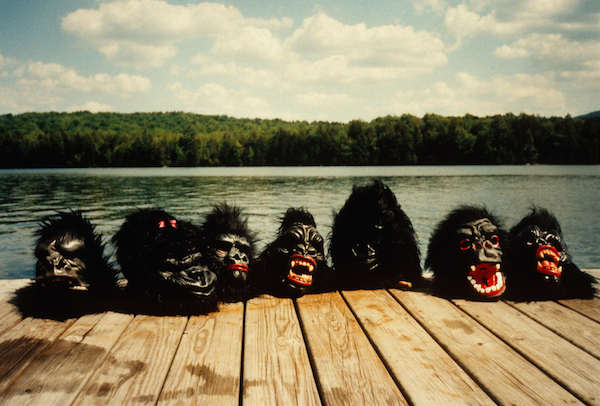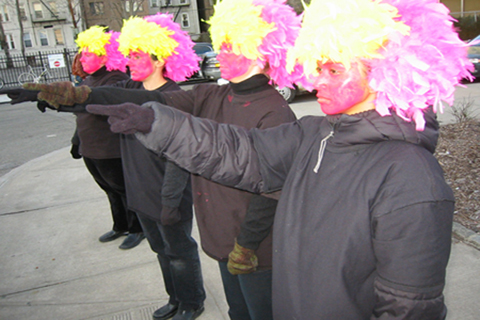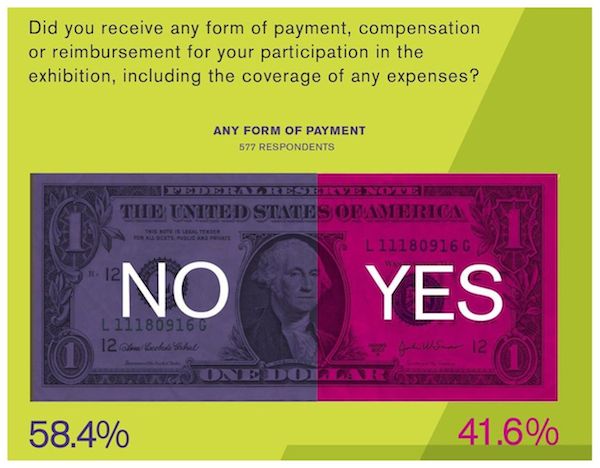Galleries
Why Are There Still So Few Successful Female Artists?
Gender inequality is back at the center of art-world discussion. What can be done about it?

Gender inequality is back at the center of art-world discussion. What can be done about it?

Ben Davis

![Guerrilla Girls, <em>[no title]</em> (from "Guerrilla Girls Talk Back") (1985-90)<br> Photo: Courtesy Tate Modern](https://news.artnet.com/app/news-upload/2015/06/guerrilla-girls-wage-inequality.jpg)
Guerrilla Girls, [no title] (from “Guerrilla Girls Talk Back”) (1985-90).
Photo: Courtesy Tate Modern.
What will it take to finally put an end to sexism in art?
Currently this subject is back at center stage, thanks to the Maura Reilly guest-edited June issue of ARTnews which collates the dispiriting statistics, and elicits responses from art stars ranging from Cindy Sherman to Jamian Juliano-Villani.
Things are a lot better than in the mid-80s, when the Guerrilla Girls formed to picket a Museum of Modern Art survey that contained just 13 women in a show of 169 artists. But they are still not great: of all artists represented by galleries in the United States today, just 30 percent are female, according to the stats from Micol Hebron‘s “Gallery Tally” project, cited by Reilly. And that total seems to have been stuck more or less in place for some time.
Reilly’s effort has provoked major discussion. On the other hand, it has also provoked a major sense of déjà vu. Cindy Rucker Gallery has organized a response show, cheekily titled “Pussy Don’t Fail Me Now.” The flyer for it begins: “On the heels of yet another expose of gender inequalities in the art world…”
Last year, in a special issue of the Brooklyn Rail, edited by Kara Rooney and covering very similar terrain, artist and critic Mira Schor calls these periodic upsurges of feminism “amnesiac returns” (in fact, stressing the point, her piece was called “Amnesiac Return Amnesiac Return.”) Every few years, it seems, there is a resurgence of interest in feminism, noting the dismal progress towards gender parity within this purportedly liberal realm. Statistics are collated; symposia held; protests organized.
Then, before long, the subject fades from the center of discussion—only to return again a few years later, because the problem persists.
To accompany Reilly’s effort, ARTnews also republished online Linda Nochlin’s celebrated 1971 essay “Why Have There Been No Great Women Artists?” I am keenly aware that in what follows I am at risk of coming off as mansplaining sexism, but rereading Nochlin was a revelation. It made me think that a return to some of the insights of her classic feminist scholarship might help advance the contemporary conversation—including my own previous thoughts on the subject.

The cover of ARTnews, January 1971.
The Limits of Counting
Reilly’s lead essay is titled “Taking the Measure of Sexism: Facts, Figures, and Fixes.” It is, in essence, an epic exercise in counting, surveying the statistics that prove ongoing bias in gallery representation, auction prices, and museum solo shows.
Counting is one of the “fixes” as well. After surveying possible avenues of redress, like advocating for feminist curricula and pressuring collectors and museum boards to change their ways, Reilly concludes by saying, “And, yes, we need to keep crunching the numbers. Counting is, after all, a feminist strategy.”
Indeed, such data-gathering is what continues to keep the issue alive despite the industry’s memory problem. Yet going back to read “Why Have There Been No Great Women Artists?” again, I was suddenly struck by how Nochlin’s approach can be read as a critique of counting as an endpoint of analysis.
“The question ‘Why have there been no great women artists?’ is simply the top tenth of an iceberg of misinterpretation and misconception,” Nochlin wrote.
You could rephrase her argument like this: Simply counting the number of “great” female artists then comparing it to the number of “great” male artists didn’t by itself explain anything, and left room to smuggle in all kinds of erroneous assumptions, unless the source of the discrepancy was adequately explained.
Cutting ahead to our own time, the question being asked is “Why Are There Still So Few Successful Women Artists?” Yet as with the earlier case, in taking only the most visible phenomena of professional attainment as its object, the statistics on their own leave only our assumptions to fill in why bias appears to be so intractable.
Nochlin argued that in order to understand why women have been underrepresented in art history, we needed to look “beyond the specific political and ideological issues involved in the subjection of women.” We had to dig into the premise of the question itself, framing artistic careers not as the manifestation of inbuilt “greatness” but as the product of institutional structures. Only after these were understood could we give the numbers their proper meaning.
Correspondingly, today I think that it may be helpful to take a closer look at what “success” really means and how it is achieved. As in the earlier case, to do this it helps to look more closely about our ideas not just about female artists, but about the way the contemporary art system in general works (or doesn’t).

The activist group the Brainstormers, “pointing out” the gender imbalance at the 2005 “Greater New York” show at MoMA PS1.
The Conditions for Artistic Success
Eight years ago, after another return of feminist protest against festering bias within the art system, I wrote an essay trying to answer some of these questions, titled “White Walls, Glass Ceiling” (which, in updated form, became an important part of my book 9.5 Theses on Art and Class). There I argued that “you can’t explain this phenomenon without getting at factors larger than just art,” and proposed two possible channels by which the outwardly progressive art world might reproduce sexism.
The first was that the commercial art industry was about servicing the appetites of the wealthy. Given the not-at-all equal distribution of wealth in society, this reality ultimately meant that it was about servicing the appetites of men—a state of affairs bound to produce bias.
The second was that, when you examined how artists achieved gallery representation, it was through relatively invisible personal networks. Grasping this, I thought, might explain how a “boy’s club” mentality replicated itself, consciously or unconsciously.
I still believe that these factors are important. Yet after the activism and debate of the ensuing years, I have come to believe that my account in “White Walls, Glass Ceiling” is still too art-world centric. Today, I would put more stress on a third factor.
One of the major recent themes of theoretical and practical debate—in the scholarship of Julia Bryan-Wilson and the activism of W.A.G.E. (and in my own book)—has been about the status of the artist as worker. It has become increasingly clear to me that the idea of the “artist” as a professional identity is a near myth, an optical illusion produced by what Nochlin would describe as the “romantic, elitist, individual-glorifying and monograph-producing substructure” of the art industry.
For almost all contemporary “artists,” including a majority of those who are actively showing in galleries, art sales constitute a fraction of how they make a living. The reality of the art life is largely one of maintaining faith in a creative vision while doing something else (unless you are independently wealthy or supported by a partner, situations more characteristic of the average artistic success story than anybody cares to talk about).
Every year, a hungry new crop of would-be artists enters the lottery, even as another bunch decides to abandon the field, having exhausted their resources or their optimism. Summing up years of hard-won wisdom recently in the book Living and Sustaining a Creative Life, the artist Maureen Connor put it this way: “[I]f some career trajectories seem arbitrary in terms of who succeeds and who does not, I believe it often comes down to crucial financial support.”
Nochlin used the metaphor of the iceberg. If the statistics about “successful” artists are the peak that we can see, the realities within the non-art economy are the cold mass that these rest on, largely hidden beneath the surface of the conversation.

W.A.G.E., “Artist Payment Graphic,” excerpt from W.A.G.E. graphic poster of artist survey results (2011).
Source: www.wageforwork.com.
The Pay Gap and the Representation Gap
What does this fact, which is as characteristic of men as it is for women, help us understand about the specific condition of female artists?
Responding to Reilly’s article in ARTnews, the women behind the Brooklyn gallery Cleopatra’s suggest that aspiring female artists may get fewer opportunities because they are less aggressive about promoting themselves: “Hands down the biggest observation that we have made in the role of being four perfect targets for artists to approach, pitch projects to, ask for a studio visit, etc., is that probably nine out of ten people to hit us up are men.”
Maybe if aspiring female artists really did just “lean in,” things would improve. Gender stereotyping sets in early, and means that women are sometimes socialized to ask for less.
But I believe with Nochlin that ultimately “the question of women’s equality—in art as in any other realm—devolves not upon the relative benevolence or ill-will of individual men, nor the self-confidence or abjectness of individual women, but rather on the very nature of our institutional structures themselves and the view of reality which they impose on the human beings who are part of them.”
So here’s a third avenue towards an explanation of the same observation: Maybe, for reasons that go beyond art, even the most assertive aspiring female artist actually ends up with less time to approach dealers, pitch projects, and ask for studio visits.
The vicious truth is that female college graduates today still make about 22 percent less than their male counterparts, across the economy.
Women, on average, will therefore have 22 percent fewer resources to go into making and producing art. Women will, on average, have to work 22 percent harder to compete at the same level for scarce opportunities. Women will have 22 percent less of the “crucial financial support” Connor talks about to see them through while waiting for that big break.
For African-American women and Latinas, the statistics on relative pay are even more dismal. An African-American woman can in general expect to make 36 percent less than a white male. As the National Partnership for Women & Families pointed out recently, that translates to the equivalent of 21 months of rent.
And the pay gap is really only one of the more visible aspects of routine discrimination, from the US’s spectacular failure among industrialized nations to mandate any form of maternity leave, to the nickle-and-diming stupidity of the so-called “pink tax,” the fact the same goods, like razors and deodorants, tend to cost more when packaged for women (an issue publicized by the French feminist collective Georgette Sand last year).
Here maybe the iceberg metaphor is still too benign. If artistic careers are mainly subsidized by resources from outside of art, such realities will be more like a black hole in the art universe—not directly visible, but warping all that is around it.

From the Guerrilla Girls BroadBand’s show “#ProvokeProtestPrevail,” recently at the Bruce High Quality Foundation University.
Photo: Guerrilla Girls.
The Art World and the Real World
I know that the danger in this analysis is that it may seem as if I am downplaying sexism within the art industry. Some portion of discrimination is the work of base ignorance or outright misogyny (cough cough, Georg Baselitz). There are plenty of female artists who have achieved artistic “greatness” but still go unrecognized.
It was not so long ago that Evening Standard critic Brian Sewell was opining, with dumbbell assurance, “Only men are capable of aesthetic greatness.”
Yet even sexism of this blatantly regressive kind finds its purchase in terrain shaped by the larger context for women. How did Sewell justify for himself his asinine generalization about female creative capacity? With the following observation about the career paths of female artists: “[T]hey fade away in their late 20s or 30s. Maybe it’s something to do with bearing children.”
Well, maybe—or maybe it’s something to do with having to work extra hard to stay in the game and then, on top of that, having some fool still say that you’ll never achieve “aesthetic greatness.”
In the end, exposing the fact that conditions within art depend crucially on factors that go beyond it shouldn’t let the art world off the hook. In fact, it makes corrective initiatives within art more, not less, important; K8 Hardy specifically makes the case for artists fees on this basis.
But it does mean that the shameful statistics probably can never be cancelled out by simply getting attitudes right within the art industry. The numbers within art make a case for a feminism that advances discussion and activism beyond it.
The Guerrilla Girls are the godmothers of counting as a political strategy. Yet it is already a decade and a half now since the great “Banana Split” of 2001, when Guerrilla Girls BroadBand spun off as a group as committed to addressing issues beyond sexism in art. These have included, among other things, abortion rights, sexual assault, military recruiting, and discrimination against women within the workplace.
Recently Minnette De Silva, one of the pseudonymous members of the BroadBand collective, explained the new direction to the Brooklyn Rail‘s Chloe Wyma:
What Guerrilla Girls BroadBand does is stand in the art world and relate it back out to the rest of the world. What’s really important about the continued inequality of representation of women and people of color in the art world is that the whole of American society is still incredibly racist and anti-women in certain ways. We see the art world as part of the world.
This is not an example of diluting the message. This is an example of wisdom, won through struggle, about what it actually means to take that message seriously.
See also:
100 Most Powerful Women in Art